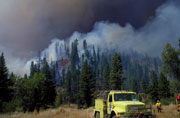- Number 288 |
- June 8, 2009
Smoke and fire: New toxins found in forest fire smoke

Image courtesy of Bureau of
Land Management
Smoke from burning ponderosa pines contains previously undetected toxins, or alkaloids, according to a study to be published June 1 in Environmental Science and Technology by scientists at DOE's Pacific Northwest National Laboratory. The alkaloids are potent mutagens that can affect human health and ecosystems in areas near or downwind of the fires. Researchers have long suspected the presence of alkaloids in smoke particles produced in forest fires, but no direct measurements had been made.
With the help of the Forest Service Fire Sciences Laboratory in Missoula, Montana, the team sampled smoke from smoldering test fires of ponderosa pine and underbrush. They then devised a method that provides highly detailed information about the smoke’s composition, using high-resolution mass spectrometry capabilities at DOE’s EMSL—the Environmental Molecular Sciences Laboratory on PNNL’s campus. Compared to other studies, the team found that 70% of the molecules detected in the smoke had not been previously reported. More than 30% of newly detected species were alkaloids.
“The research significantly expanded the previous observations,” said study co-author Alex Laskin.
Alkaloids may present a considerable source of basic compounds in smoke particles, which can impact cloud formation processes important to agriculture and water supplies. The researchers also found that smoldering fires such as those in controlled burns produce more alkaloids than blazing fires. Because some alkaloids might be harmful, the result could affect planned fires upwind of human populations.
The study is funded by DOE’s Office of Basic Energy Science and Office of Biological and Environmental Research as well as PNNL’s Science Undergraduate Laboratory Internship program.
Submitted by DOE's Pacific Northwest National Laboratory
